There was no reason to write an article like this until I met a friend’s pet parrot, which was obviously the most colorful one I had ever seen. Its name, I learned, was “the scarlet macaw,” and its gorgeously contrasting red, yellow, blue, and green feathers were one of its many distinguishing features. That royal beast caught my attention, and that’s how I came up with the idea for this article. This post will teach you about 25 unique red, blue, and yellow birds. Some of them are so colorful that you might even find them a bit unrealistic. Hence, without further ado, read till the end. Happy scrolling!
Here Are 25 Unique Red Blue And Yellow Birds
1. Painted Bunting

- Scientific name – Passerina ciris
- Habitat – Woodland edges, roadsides, brush, towns, gardens
- Diet – Mostly seeds and insects
This bird is so bright and colorful that it may easily fool you into thinking it belongs to the canvas, much like a piece of a child’s or artist’s Imaginary world. Even their name is unique and perfectly reflects the personality of these beautiful Red Blue and Yellow Birds, which consistently rank #1 on the list.
2. Yellow Rosella
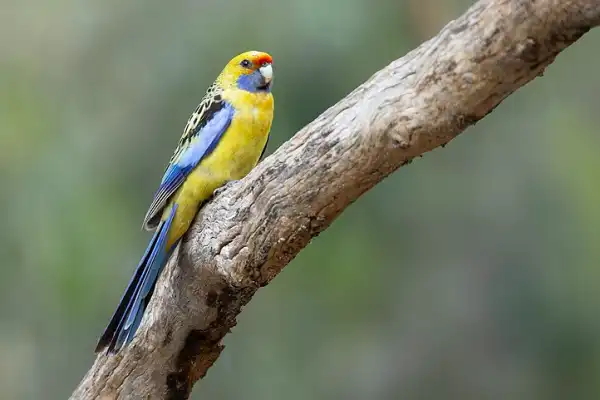
- Scientific name – Platycercus elegans
- Habitat – coastal and mountain forests at all altitudes
- Diet – grass seeds, herbs, fruits and berries, nuts, insect larvae, and flower buds
This bird always has a very vibrant blue and crimson hue, with sporadic patches of faded yellow. Even the blue in it can occasionally get darker and take on a purplish hue.
Crimson Rosellas usually live in tiny groups and are drawn to garden seed trays. Eucalyptus seeds, grasses, shrubs, insects, and certain tree flowers are examples of their natural meals.
3. Scarlet Macaw
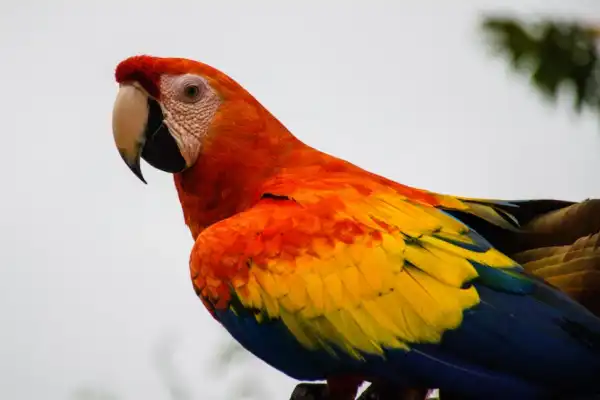
- Scientific name – Ara macao
- Habitat – tall, deciduous trees in forests and near rivers
- Diet – Nuts, leaves, berries, and seeds from the rainforest
Large red, yellow, and blue birds, the Scarlet Macaws, are native to humid evergreen forests in the Neotropical regions of the Americas.
Despite having three primary hues, this bird most likely has every rainbow shade. Due to issues including habitat loss from rainforest destruction and high exploitation for the pet trade, these incredibly pretty parrots are in danger of going extinct.
4. Blue Winged Pitta

- Scientific name – Pitta moluccensis
- Habitat – moist woodland, parks and gardens
- Diet – worms and insects
The blue-winged pitta, a stunning bird with delicate colors, is typically found in tropical woodlands. Its beauty is worth seeing because of the subtle tones of green, yellow, red, and blue on its wings.
Additionally, its face is easily recognizable due to the thick, dark black line that runs across it.
5. Blue Pitta
- Scientific name – Hydrornis cyaneus
- Habitat – lowland and montane moist evergreen forest with bamboos, often near streams
- Diet – worms and insects
It’s a bird with a predominantly blue body (having some darker patterns) and an entirely yellow head (again, patterned!). Plus, its head has a crimson patch on top of it. So, with its mere defining features, you must have been admitting that this is an incredible beauty. Since we actually do!
6. Green-Tailed Sunbird

- Scientific name – Aethopyga nipalensis
- Habitat – temperate forests and subtropical or tropical moist montane forests
- Diet – small arthropods and nectar
This is an amazing species, with a dramatic, shiny blue head and brilliant red and yellow shoulder and belly contrasting colors.
Aka the Nepal yellow-backed sunbird, this bird species is found in portions of Southeast Asia, Nepal, and the northern Indian subcontinent.
7. Brown-Throated Sunbird
- Scientific name – Anthreptes malacensis
- Habitat – semi-open habitats in south-east Asia
- Diet – nectar, small fruits, and berries. Juveniles feed on insects
The name comes from the fact that this sunbird is primarily yellow with a mix of brown, especially along the throat. Aside from that, it contains subtle metallic undertones of crimson, blue, purple, and emerald over its head.
Thanks to these attributes they are easy to distinguish from their relatives.
8. Ruby-Cheeked Sunbird
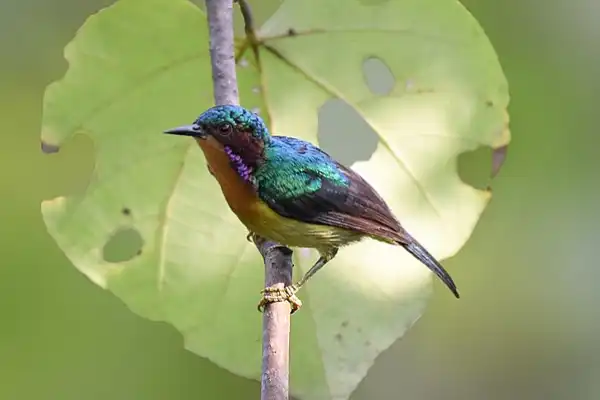
- Scientific name – Chalcoparia singalensis
- Habitat – subtropical or tropical moist lowland forest
- Diet – Insects, including caterpillars and spiders, fruit, pollen, and nectar.
This small sunbird shares unique characteristics with no other bird, including its metallic blue upperparts, wine-red (or ruby) cheeks, brilliant orange throat, and chest. It also has a short, sharp bill. Thus, in our list of Red Blue, and Yellow Birds, this little beauty stands out.
9. Green Rosella
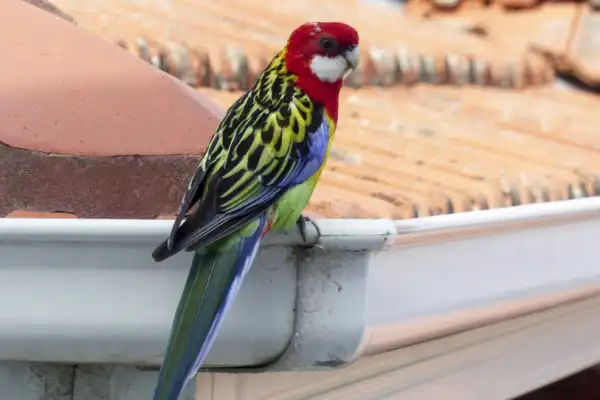
- Scientific name – Platycercus caledonicus
- Habitat – dense moist forests and savanna woodlands
- Diet – seeds of grasses, shrubs and trees, fruits, buds and flowers, nectar, insects and larvae
This parrot is not entirely green, despite its name, which is why it is included on our list of red, blue, and yellow birds. Different from others on this list, the green rosella has a mostly faded greenish-yellow body, with only a hint of blue and red on its face (on throat and forehead, respectively). Its wings also have a little bit of blue color.
10. Himalayan Monal
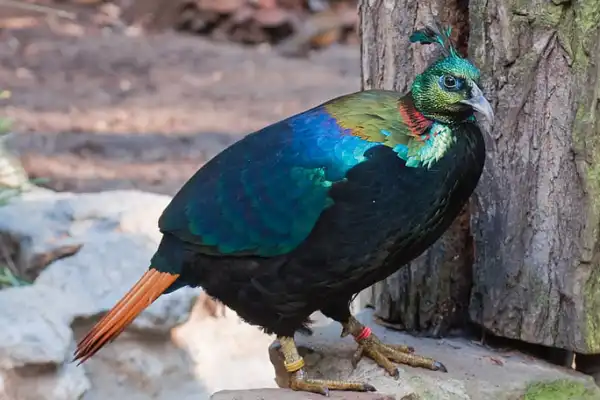
- Scientific name – Lophophorus impejanus
- Habitat – Himalayas
- Diet – carnivores (insectivores) and herbivores
The male, with his rainbow-colored plumage, green-crowned head, red neck, green shoulders, blue back, orange tail, and black underparts, portrays iridescence. The female has a pale blue eye patch, a white throat, and a streaky brown body; she is not quite as colorful as the male. They are common around Himalayan highland forests.
11. Lady Gouldian Finch
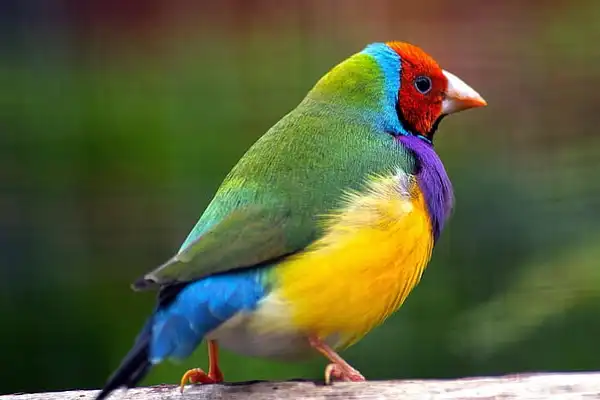
- Scientific name – Erythrura gouldiae
- Habitat – isolated areas, mostly within the top end of the Northern Territory and the Kimberley region of Western Australia
- Diet – seeds, fruits and veggies
Another bird with such vivid colors that nearly seems like it belongs in a work of fiction or an animated film! Native to Australia, the Lady Gouldian Finch is a beautiful passerine bird often referred to as the Gould’s finch or the rainbow finch.
Surprisingly, Gouldians are good at “watching only” birds; in fact, handling them may trigger them to become anxious and even kill them. For these delicate birds, stress can be fatal.
12. Lilac-Breasted Roller
- Scientific name – Coracias caudatus
- Habitat – open woodland and savanna
- Diet – arthropods and small invertebrates
The lilac-breasted roller is an African bird. In fact, because of the variety of colors on its feather coat, it is the national bird of Kenya.
Green, white, black, yellow, turquoise, dark blue, red, brown, and lilac make up its roughly (8) total colors. It thus makes sense that it should appear in our list of red, blue, and yellow birds.
13. The Golden Pheasant
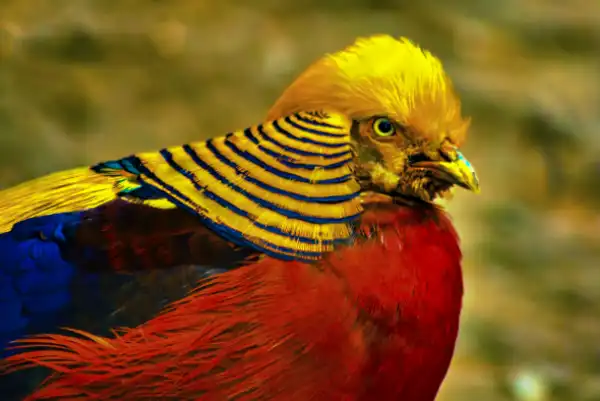
- Scientific name – Chrysolophus pictus
- Habitat – mountainous forests of western China, parts of western Europe, North America, South America
- Diet – berries, grubs, seeds, leaves, tender shoots of shrubs and bamboo
The Golden Pheasant is a yellow-red bird with blue highlights on its wings and body. The adult individuals are super easy to distinguish due to their unusual appearance. The striking contrast between the bright yellow and orangish-red will draw every inch of your attention.
Native to the mountainous regions of China, this bird is surprisingly shy and will probably run away at minor disturbance.
14. African Pygmy Kingfisher
- Scientific name – Ispidina picta
- Habitat – woodland, savanna, and coastal forest
- Diet – insects like grasshoppers, praying mantis, worms, crickets, dragonflies, cockroaches and moths
This tiny woodland kingfisher is a gem to spot. Pay attention to the slender, dark blue crown and the orange face with a purple cheek mark. Hence, it is no less than a sight to behold if you’re a nature enthusiast.
They exist in specific forests, particularly dense stands. You may be surprised to know at times, this bird can go completely unnoticeable bird that sits still for long periods before swooping in to catch prey.
15. Rainbow Lorikeet
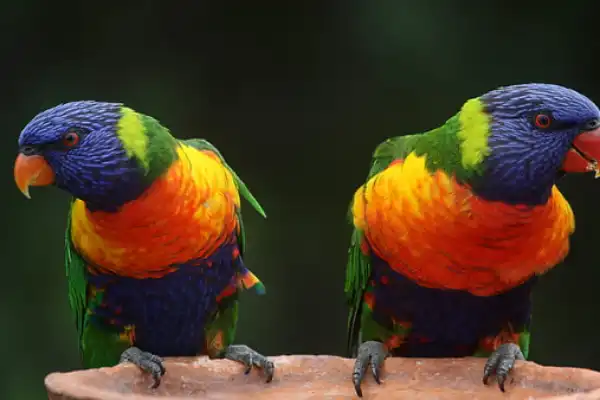
- Scientific name – Trichoglossus moluccanus
- Habitat – rainforest, coastal bush and woodland areas
- Diet – pollen and nectar of flowering plants
Australia is home to the rainbow lorikeet, a kind of parrot. It is frequent to spot them around northern Queensland to South Australia. Its natural habitats are wooded regions, coastal bush, and rainforests.
It’s a bright, colorful, medium-sized red and blue bird with a predominance of green too.
With a greenish-yellow nuchal collar and a deep blue tint over the head, their upper parts (tail, wings, and back) are all green. The chest, however, is yellow or orange. The thighs and rump are green, while the belly appears deep blue.
16. Resplendent Quetzal
- Scientific name – Pharomachrus mocinno
- Habitat – cloud forests from southern Mexico to Panama
- Diet – mostly omnivorous
Resplendent Quetzal is a perfect illustration of a blue-green-red bird with undertones of yellow. Additionally, it has a tiny yellow bill that makes it really cute.
This little bird inhabits tropical forests, especially montane cloud forests, and can be found throughout southern Mexico and Central America.
17. Sun Conure
- Scientific name – Aratinga solstitialis
- Habitat – inland tropical habitats, and some dry savanna woodlands and coastal forests
- Diet – mainly feed on fruits, flowers, berries, blossoms, seeds, nuts, and insects
The medium-sized, brilliantly colored sun conure, sometimes known as the sun parakeet, is a native of northern South America. The grown-up individuals have green and blue-tipped wings and tails, orange or red flushed underparts and faces, and black beaks. Yet, their plumage is primarily golden-yellow. Consequently, it makes perfect sense for us to include it in our list of red blue, and yellow birds.
18. Western Rosella
- Scientific name – Platycercus icterotis
- Habitat – open eucalypt forest and timbered areas, including cultivated land and orchards
- Diet – seeds of grasses and other plants, as well as fruits, flowers, insects and their larvae
The western rosella is a parrot endemic to southwestern Australia, often known as the moyadong. Its head and underparts are vivid red, and patches of various blue, green, and black hues covering its entire back. Remarkably, it differs from others of the genus by a yellow patch on the cheek. Therefore, these features make it a species with the most hues of red and blue among birds.
19. Keel-Billed Toucan
- Scientific name – Ramphastos sulfuratus
- Habitat – tropical and sub-tropical rainforests from southern Mexico to Venezuela and Colombia.
- Diet – fruits, and occasionally insects and lizards
On our list, this one is certainly the oddest. Merely due to the fact that its body is just partially yellow and mostly black. With due credit to its bill, we anyway had to include this among the red, blue, and yellow birds.
The most creatively evolved bills are those of toucans, and this one contains 4 colors: red, orange, blue, and green, with some yellow undertone. Captivating, no?
20. Wilson’s Bird-of-Paradise
https://in.pinterest.com/pin/504332858273603428/
- Scientific name – Cicinnurus respublica
- Habitat – lowland rainforest and middle mountain forests
- Diet – mainly fruit, and some small insects
A pretty small bird found in the Waigeo and Batanta Islands’ foothill forests off the coast of West Papua. Due to habitat destruction, a restricted range, and overexploitation, the IUCN lists this species as nearly threatened.
The most remarkable aspect of Wilson’s Bird-of-Paradise is its flattened, blue, curled tail feathers, which give it an exceptional and unrealistic appearance.
21. Red-Necked Tanager
- Scientific name – Tangara cyanocephala
- Habitat – subtropical or tropical moist lowland forest and heavily degraded former forest
- Diet – fruits and small insects
The red-necked tanager is a blue-green-yellow-red bird found in Paraguay, Argentina, and Brazil. Its natural habitats are badly degraded former forests and moist lowland forests in tropical or subtropical regions.
It’s a pretty little tanager, primarily green in color with a blue throat and crown (bare head) and red cheeks and nape. Additionally, females have a speckled black back, which makes them duller than males, who have a black back.
22. Mandarin Duck
- Scientific name – Aix galericulata
- Habitat – forests of China and Japan
- Diet – mainly eat plants and seeds, especially beech mast
The Mandarin Duck is one of the most beautiful species of perching ducks unique to the East Palearctic. It exhibits sexual dimorphism, with males and females differing dramatically. They have exquisite patterns in shades of brown, yellow, green, blue, and black. Moreover, they have a red bill.
23. Paradise Tanager
- Scientific name – Tangara chilensis
- Habitat – Amazon rainforest
- Diet – fruits and arthropods
The Paradise tanager inhabits the lowlands of the Amazon and is a small, stunning, and colorful bird. Their predominantly black, blue, and red body contrasts sharply with their vivid green head. It seems to have precisely the right amount of color contrast. In addition to red, its wings might also have yellow coloration.
24. Curl-Crested Aracari
- Scientific name – Pteroglossus beauharnaesii
- Habitat – tropical moist lowland forests
- Diet – mainly fruits, and sometimes eggs and nestlings
Here, we have another explicitly colorful toucan on our list of red, blue, and yellow birds. Found in Bolivia, Brazil, and Peru, the curl-crested araçari is a near-passerine bird. Their bodies are colorful, with an equal blend of red, yellow, and brown. Additionally, the area around its eyes and beak only sporadically has marine blue highlights.
25. Scarlet-Chested Parakeet
- Scientific name – Neophema splendida
- Habitat – open woodlands of eucalypts, she-oak, mulga, and saltbush
- Diet – herbivores
It doesn’t care what name you give it—the splendid parrot, orange-throated parrot, or scarlet-chested parrot! This stunningly colorful parrot, which is native to inland southern Western Australia and central South Australia, has equal parts blue, red, orange, green, and yellow in its coat.
They have nomadic traits and a small body, with a charming cobalt blue face.
CONCLUSION
Here are the most magnificent red, blue, and yellow birds to conclude our article. Make sure you explore the depths of our existing blogs’ knowledge until we have another informative post.

Anjali Prasad, a B. Pharm. graduate who works as a content writer for HowItSee, is based in Delhi. Except for her, not many people take the typical road from healthcare to writing. Her love of writing stemmed from her involvement in the college literature society and her early journaling at the age of 7. Hence, the love of learning and the spirit of exploration are what drew her to this career. You can find her on common social media like Instagram.
